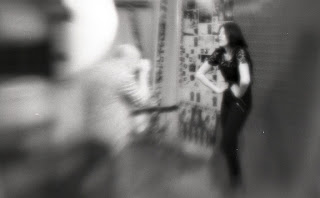On June 21st we celebrated Go Skateboarding Day. So, isn't it appropriate that we also give you a skateboarding LomoAmigo? We present to you the work of Marcelo Mug, Brazilian skateboarder and photographer who is always with his Holga 120 capturing the skateboarding scene.
How did photography enter your life?
I always had access to a lot of magazines and newspapers at home. I constantly found myself giving the photographs in them special attention. When I started skateboarding, I ate up magazines, I spent hours looking at each photograph and wondering how the camera had been held to capture it, what lens was used, how the camera was stabilized, how many flashes were fired, that sort of stuff.
Later, I finally borrowed a Pentax SP100 from my parents and went to the street to shoot my friends skateboarding. I later realized I was spending all my money on films and development, even before buying my first camera.
Jr. Pig – Frontside Hurricane – Vale do Anhangabaú
I think you started to skate from an early age, at what point did you decide to turn that fun into your lifestyle and work?
I did skateboard photography as a parallel to my life for a long time, finding time between being an intern at a TC channel and going to college for Radio and TV. When I graduated, I was offered a full time position on the TV channel and also got an invitation to work at Tribo Skate Magazine as a copywriter and photographer. Being able to work on my two passions, skateboarding and photography, was a great privilege, then my personal accomplishment outweighed the choice of the financial return, and I ended up accepting the opportunity in the Tribo Magazine. It was from there that skateboarding invaded my life twenty-four hours a day, seven days a week, 365 days a year.
Images made in Ecuador in his recent trip with the professional skateboarder Otávio Neto.
In a time where analogue photography is attacked by an avalanche of digital camera models, why do you still choose to use analogue cameras?
First because the pleasure that comes from analogue photography, like the anxiety to see the result of a photo. Second, because it is impossible to get the texture and the color produced by film, even with the best and most advanced photoshop filters. Lastly, because shooting with film is a good exercise for any photographer. Analogue photography forces you to think before you click, there is no compulsion to click like in digital photography.
What are the major difficulties that a skate photographer faces day-to-day?
A skate photographer can not be lazy if he wants to achieve an unprecedented picture, because he may have to jump walls, face guards, the police, run from robbers… it’s a constant adventure. But the greatest difficulty that a photographer who works with skate today in Brazil is not in the streets but behind desks: the lack of recognition in the market itself. Unfortunately, the work of photographers and filmmakers who work with skateboarding in Brazil is still undervalued.
Duane Peters, Filipe Ortiz, Homero Telles, Omar Hassan, Paulo Galera and Renato Souza are some of the skateboarders captured by Mug lensed in his “Portraits” series.
Tell us about your recent trip to Israel. Who were the skaters? How long were you there, etc..
Professional skateboarder Pablo Groll gathered all the pieces and made the trip happen. He always wanted to visit Tel Aviv, the city where his father was born and lived for more than a decade. Coincidentally a few years ago in Brazil, Pablo rediscovered a childhood friend, Homero Telles, who was just living in Tel Aviv and was also living there as a professional skateboarder. Pablo and the skateboarder Ricardo Pires invited me to the trip, and I had the privilege of registering everything during the ten-day journey. We were received very well by Homero, who took us to the best places to skate, and also showed us amazing places like the Dead Sea and the Western Wall. It was an unforgettable trip. Whoever wants to know more about this trip just take a look at the 197th edition of Revista Tribo Skate or watch the Special Skate Paradise Program Israel.
Pictures of Israel.
What photographers do you most admire and who influenced your work?
Currently I am influenced by everything, whether it be magazines, the internet, on the street, in the movies, and sometimes I don’t keep the name of the photographer, director of photography or artist. But it is clear that over time some names are appearing more often in front of you, especially those with a good authorial work, and you end up going back to see more, which is the case of Louise Chin and Ignacio Aronovich, which form the collective Lost Art. In the universe of skateboard photography, I can not forget to mention the master Shin Shikuma, with whom I learn and learned a lot, and the work of photographer Anthony Acosta, who I had the pleasure of meeting in his recent visit to Brazil.
To finish, do you want to leave a message?
Thank you family and friends, you are the foundation of everything. And a big f**k you to leeches that operate in the Brazilian skate market.
Did you liked the photos of Marcelo Mug made with his Holga 120? So take a look in more of his work here or drop by in his LomoHome.
written by lgs_saopaulo and translated by caioantunes





































